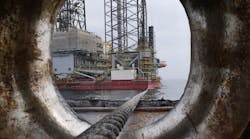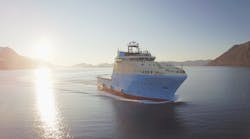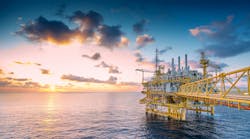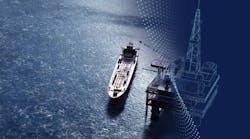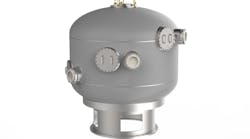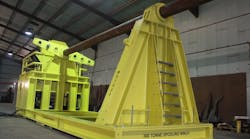Editor's note: A condensed version of this Sustainable Transportation section first appeared in the March-April 2023 issue of Offshore magazine's Energy Transformation Strategies Special Report.
Compiled by Ariana Hurtado, Editor and Director of Special Reports
Changing the primary power source for vessels
A big part of reducing the environmental impact of the maritime industry comes from how vessels are powered and deployed. Fugro is actively looking to transition from marine diesel as the primary power source toward green methanol as a low-carbon alternative. The MENENS consortium (Methanol as an Energy Step Towards Zero-Emission Dutch Shipping) has been recently awarded a grant from the Dutch government to further its work. By moving to methanol as fuel, as well as through increasing the number of uncrewed operations to enable the use of smaller vessels, the company is working toward net-zero targets. Sustainability is also being driven in the industry using remote and autonomous technologies, and Fugro has a goal there to reach net-zero emissions of its operations (Scope 1 and Scope 2) by 2035.
Green ammonia energy system for large vessels
The ShipFC project aims to demonstrate that long-range zero-emission voyages with high power on larger ships is possible. The project will see an offshore vessel, Viking Energy, which is owned and operated by Eidesvik and on contract to Equinor, have a large 2-MW ammonia fuel cell retrofitted, allowing it to sail solely on clean fuel for up to 3,000 hours annually. The ammonia used in the energy system will be produced by electrolysis. The goal of the project is also to ensure that a large fuel cell can deliver total electric power to shipboards systems safely and effectively. A significant part of the project will be the scale up of a 100-KW fuel cell to 2 MW. The ammonia fuel cell system will be installed in Viking Energy in late 2023, and this is the first time an ammonia-powered fuel cell will be installed on a vessel. Another part of the ShipFC project will perform studies on three other vessel types, namely offshore construction vessels and two cargo vessel types, to illustrate the ability to transfer this technology to other segments of the shipping industry.
Emissions monitoring tool for vessels
Maritime software optimizes fleet operations data
As an independent subsidiary of the American Bureau of Shipping (ABS), Wavesight was created to deliver maritime intelligence. ABS Wavesight’s suite of product dashboards delivers rich, real-time feedback to help fleet operators reduce their carbon footprint and drive ESG initiatives. It offers a set of tools that can organize and optimize data for fleet operations of any size. Personnel management, asset risk management and fleet performance measures are housed in one place, and users can align local and remote data into actionable insights for voyage performance optimization. The technology is designed to optimize a route in real time to boost voyage economics.
Converting offshore construction vessels to hybrids
Boskalis announced plans last year to convert various vessels in its Offshore Energy division to hybrid vessels through retrofitting energy storage systems, or “power packs.” The conversions will be designed to cut the vessels’ fuel consumption and associated CO2 and NOx emissions by up to 20%, also providing a power supply and energy storage facility while the vessels are docked. Boskalis will conduct the modifications, due to be completed by year-end 2024, on the Bokalift 1 and Bokalift 2 crane vessels, two construction support vessels and two diving support vessels, all of which have DP2 capabilities. Boskalis already employs special dashboards on its vessels to enhance efficient fuel usage and biofuels as an alternative to fossil fuels.
Energy management tool for all vessel types
Engineered by Royston, enginei is an energy management tool that monitors fuel flow and consumption for all engines, boilers and bunkering operations. For monitoring of bunkering operations, the tool automatically detects both load and discharge of fuel and provides detailed reporting, anomaly detection and a complete audit trail. Tank inventory measurement sensors also provide an overview, based on real-time data and scalable to any number of operational tanks. The tool also monitors vessel speed, position, operational mode, engine running hours and more, delivering a full management system using the latest sensing technologies. Enginei is designed to help ship owners operate their vessels cost effectively by identifying how their vessels consume energy. Royston said enginei is used on hundreds of vessels worldwide.
Platform helps cut offshore vessel emissions
SailPlan is an emissions monitoring and optimization platform that combines the real-time engine, fuel and navigational data from vessels with the weather, mapping, infrastructure and traffic data to benchmark, optimize and report fleet emissions. According to SailPlan, Harvey Gulf has seen quantifiable emissions reductions beginning with the Harvey Power, a 310-ft platform supply vessel (PSV). The company says the addition of SailPlan makes the PSV the first one in North America to be equipped with a real-time emissions optimization capability. Harvey Power is designed to run on LNG, electric battery power and ultralow sulfur diesel.
Increasing fuel efficiency of a vessel fleet
In early 2022, Solstad Offshore entered a collaboration with Wärtsilä to reduce CO2 emissions from its 90-strong offshore vessel fleet by 2030. The aims are to identify, assess and implement solutions for increasing fuel efficiency and cutting emissions. Each vessel will undergo reviews for suitable solutions, potential operational improvements and life extension measures. Solstad is targeting full carbon neutrality by 2050. Extending cuts of fuel consumption per vessel to 50% should come from optimizing energy efficiencies and retrofits to enable the vessels to operate with alternative fuels such as hydrogen, ammonia and methanol. New vessels will be designed to provide low or zero emissions from the start of operations. Wärtsilä successfully operated a combustion engine on a fuel mix with 70% ammonia content and is working on ways of raising this proportion.
Modified fuel cuts helicopter emissions
Fuel alternative for offshore supply vessels
Maersk Supply Service offers the option of lower carbon-emitting operations by running its offshore vessels on a new fuel mix. The ECO Offshore product follows the successful trial of low-carbon biofuel with marine gasoil aboard the Maersk Tender anchorhandler, in partnership with startup company The Ocean Cleanup. ECO Offshore uses hydrotreated vegetable oil, which is described as a safe, sustainable biofuel that provides the same performance as conventional fuels. During a 2021 trial for a six-week ocean-cleaning charter in the Pacific Ocean, biofuel was blended into the marine gasoil, resulting in a reduction in carbon emissions of 38.95 metric tons. According to Maersk, the program confirmed the biofuel does not compromise on safety or performance, and it does not require additional training or vessel upgrades. In September 2022, the company said it was planning to adopt the biofuel across its global fleet.
Role of ammonia in decarbonizing existing assets
In September 2022, KBR announced its plans to perform a study to develop a green ammonia-based power system for a semisubmersible drilling rig owned by Odfjell. The company will collaborate with Odfjell, Equinor and Wärtsilä to assess conversion of the diesel generators on drilling rigs units to ammonia-fueled generators. The collaboration will integrate KBR’s semisubmersible technology, Wärtsilä’s power systems, and Odfjell’s and Equinor’s operations capabilities to deliver a carbon-neutral solution. KBR is an ammonia licensor, and its K-GreeN technology produces carbon-free ammonia based on electrolysis of water.
Swedish, Irish initiatives target e-fuels from offshore wind
Vattenfall and St1 will jointly perform a study on the potential production of electrofuel (e-fuel) from offshore wind. Operations could start in 2029. Vattenfall is seeking to develop offshore wind power-based hydrogen supply infrastructure on Sweden’s west coast, while St1 plans to produce 1 MMcu. m of fuel from the hydrogen, primarily for aviation. In southern Ireland, Simply Blue Group is looking to harness energy from its pipeline of floating offshore wind projects to power large-scale e-fuel production plants. This is a synthetic fuel, manufactured using renewable electricity, water and air. CO2 from the air can be captured and combined with green hydrogen gas made from water using renewable electricity. According to the company, carbon-neutral e-fuel products can be used to power airplanes, ships and construction machinery.
Partners investigate use of biofuels on offshore fleet
Earlier this year, Eni Sustainable Mobility and Saipem signed a memorandum of understanding on use of biofuels to power Saipem’s 45-strong fleet of drilling and construction vessels, with a special focus on operations in the Mediterranean Sea. The two companies are both committed to diversifying their energy sources and reducing the carbon footprint across their offshore operations. Eni has been producing biofuels since 2014, after converting its refineries in Venice and Gela to biorefineries. Through application of Ecofining technology, biofuel products are processed from vegetable raw materials or animal waste. Saipem said it aims to increase the use of alternative fuels on its vessels to cut its own and its clients’ emissions. Using biofuel, it aims for emissions cuts of about 550,000 metric tons per year of CO2, equivalent to 60% of its total annual Scope 1 emissions.





